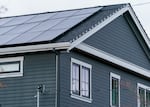Oregon lawmakers are back in session, and they have housing on their minds. So do people who want to address climate change.
Oregonians have increasingly asked their representatives to make building housing easier, both to help reduce costs for renters and home buyers and to address unsanctioned camping around the state.
Climate advocates, meanwhile, see a chance to make buildings new and old more energy efficient amid all that building. They’re also asking lawmakers gathered at the Capitol for more accountability on climate action and to set the state up for success if it receives billions in federal funding for more clean energy retrofits.

The rooftop solar array on a south-facing roof, at the home of Will Musser IV of Portland, Dec. 1, 2022. The single-family home has been retrofitted to reduce the family’s carbon footprint, and is equipped with solar panels, hybrid heat pump hot water heater, high-efficiency appliances and lighting, an electric vehicle charging station and a whole-home battery storage system.
Kristyna Wentz-Graff / OPB
New buildings codes, retrofits and energy efficiency
The burning of fossil fuels like coal, oil and natural gas is driving human-caused climate change. And over the past decade, Oregonians all around the state have begun to feel its effects: more intense wildfires, extreme heat and drought. As the state continues the clean energy transition in the transportation sector — the largest greenhouse gas emitter — its focus is beginning to broaden. According to the Oregon Department of Environmental Quality’s sector-based data, the residential and commercial sector is the second largest carbon emitter in the state. Those emissions mostly come from burning fossil fuels to power homes and buildings. And that has gotten the attention of legislators this session.
State Rep. Pam Marsh, D-Southern Jackson County, is the chair of the House Committee on Climate, Energy and Environment. She said buildings and energy efficiency are major topics this session. Marsh said most of the upcoming legislation for new and existing buildings will come from recommendations made by the Resilient Buildings Task Force, a committee made up of legislators and a diverse group of interests and perspectives, from utilities to environmental groups to school districts to labor unions. The recommendations include incentives for heat pumps and other energy-efficient appliances, creating building codes for new buildings that would reduce energy consumption, and launching policies to retrofit all state and local government buildings by 2035 to lead by example.
Meredith Connolly, the director of Climate Solutions Oregon, served on the Resilient Buildings Task Force. She said the goal was to identify policies the state could adopt that would reduce greenhouse gas emissions while creating buildings that run on clean energy moving forward.
“Oregon has made some incredible strides to clean up our electric grid and start to transition our transportation sector, but the building sector is the second biggest source of climate pollution, and we need to see more progress there,” Connolly said. “I’m hoping to see some cornerstone policies that set a framework for our built environment to reduce pollution and increase the resilience of our homes and buildings in the face of climate impacts.”
Connolly said her organization hopes legislators will pass a building performance standard, which would establish performance levels and improvements buildings must achieve around energy and water use, as well as carbon emissions. Connolly and others said such a standard would improve the energy efficiency of large commercial buildings over time and construct new buildings with stricter codes. She also said she hopes to see legislation that would transition government buildings to all-electric energy and upgrade schools’ heating, air conditioning and ventilation systems to be more energy efficient and reduce pollution.
“We have to not repeat the mistakes of the past, but just spend the time and dollars to build differently, to really prioritize frontline communities in how we transition to a clean energy economy,” she said.
Taking advantage of federal funds
Another major focus of the task force was figuring out how Oregon could obtain federal funds from the Inflation Reduction Act, which is set to invest $369 billion in clean energy and climate action. Oregon Environmental Council’s climate program director Nora Apter said the state government needs to make sure there are strong programs in place that make it easy for Oregonians to see these benefits as they improve their homes.

A cooling/heating unit installed in an apartment on June 27, 2022, provided by the Portland Clean Energy Fund working with Verde. The units at Verde are available to people over 60, with a medical condition that can be affected by heat, and/or live alone.
Kristyna Wentz-Graff / OPB
“We’re talking about $370 billion just for climate and clean energy,” she said. “Obviously that’s not all going to Oregon, but there are a lot of steps that the state can and should take this session to best position us for success in leveraging those dollars and translating them into meaningful benefits for Oregonians.”
Apter said that could mean having more staff at state agencies and setting up a system that provides direction on what money Oregon should go after.
“I think there’s ever-increasing awareness that this session is going to be absolutely key to making the most of federal investments,” she said. “The theme is really opportunity, excitement for innovation and a vision for what accelerating the transition to a clean energy economy looks like for Oregon.”
Following through on past efforts
Energy efficiency, federal funding and new codes for buildings aren’t the only top climate priorities this session. Marsh said Oregon needs to ensure it is continuing to follow the ambitious climate goals set by Gov. Kate Brown. One of those is House Bill 2021, which requires electric utilities like Portland General Electric and Pacific Power to have net-neutral carbon emissions by 2040.
“It’s one thing to set the policy theoretically on the table,” Marsh said. “It’s another thing to follow through and make sure that we’re actually doing everything that we need.”
Marsh also pointed out Executive Order 20-04, which requires state agencies to identify and reduce greenhouse gas emissions. She said she plans to seek legislation that reaffirms the climate goals set in place by Brown.
“Following through and monitoring that process, I think, is a big responsibility of the Legislature and something that we’re going to start on our very first day,” she said.
Building for climate disasters
Marsh said the state could also see legislation on building community resilience to the effects of climate change. Last year, an Oregon Health Authority study showed how extreme weather events are impacting youth’s mental health, from anger to shame and survivor’s guilt, as they deal with the consequences of climate change.
But Marsh said the state needs to look into building resilience as well as ensuring Oregon’s power grid can also handle climate change.
During the 2020 Labor Day fires, many residents across the state lost their homes due to wildfires. In Southern Oregon, the Almeda fire destroyed more than 2,600 homes and businesses In Gates, many residents saw the same fate and filed a class action lawsuit claiming the wildfire that burned down their homes in their area was ignited by power lines.
Powerful winter storms have also left tens of thousands of Oregonians without power as recently as December.
Some of the changes to Oregon’s power grid lawmakers seek could involve building more resilience through renewable energy. Marsh said Oregon needs to create an energy strategy that continues to look into offshore wind and renewable hydrogen.
“There’s a variety of potential out there, but we need to know how to tap all of that and weave it into a tapestry,” Marsh said.
